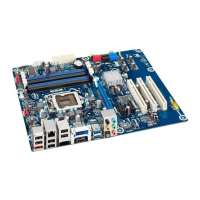
Do you have a question about the Intel DH67CL and is the answer not in the manual?
| Form Factor | ATX |
|---|---|
| Chipset | Intel H67 |
| Socket | LGA 1155 |
| Memory Slots | 4 |
| Max Memory | 32 GB |
| Memory Type | DDR3 |
| PCI Express x16 | 1 |
| PCIe 2.0 x1 Slots | 2 |
| PCI Slots | 2 |
| SATA 3Gb/s | 3 |
| SATA 6Gb/s | 2 |
| USB 3.0 Ports | 2 |
| LAN | Gigabit Ethernet |
| Video Outputs | HDMI, DVI |
| Integrated Graphics | Yes |
Provides legal information, warranties, and use limitations for Intel products.
Specifies the target audience for the product guide, typically technically qualified personnel.
Outlines the approved use cases for Intel Desktop Boards in IT equipment.
Explains the structure and chapter arrangement of the product guide.
Defines typographical conventions used for clarity in the manual.
Lists the operating systems fully and minimally supported by the desktop board.
Identifies and describes the major physical components on the desktop board.
Specifies the supported Intel processors and the LGA1155 socket compatibility.
Explains the role and functions of the Intel H67 Express Chipset.
Details memory support, including DDR3 type, channels, speed, and capacity.
Outlines the board's graphics capabilities, including integrated and discrete options.
Describes the HDMI port's video and audio capabilities and specifications.
Details the DVI-I port's support for digital and analog display connections.
Covers support for discrete graphics cards via the PCI Express x16 slot.
Describes the audio features, codec, and supported audio interfaces.
Explains the board's support for USB 3.0 and USB 2.0 ports.
Lists the expansion slots available for adding peripherals and components.
Describes the BIOS functions, setup program, and auto-configuration utilities.
Details BIOS security features for restricting access and booting.
Explains system monitoring for temperature, voltage, and fan speed management.
Outlines power management features, including ACPI and various wake-up capabilities.
Details hardware aspects related to power management and system connectivity.
Provides essential precautions and guidelines before starting any installation procedures.
Lists critical safety warnings to prevent injury and equipment damage.
Instructions for installing the I/O shield into the computer chassis for protection.
Detailed instructions for installing and removing the CPU from its socket.
Guides on how to attach the processor fan and heat sink assembly correctly.
Provides step-by-step guides for installing and removing RAM modules.
Explains how to configure memory modules for optimal dual-channel performance.
Step-by-step instructions for inserting memory modules into the DIMM sockets.
Covers the procedures for installing and removing graphics cards in the PCIe x16 slot.
Guides on connecting internal SATA hard drives and SSDs to the motherboard.
Instructions for connecting internal headers for front panel functions and other components.
Instructions for connecting chassis fans and main power supply cables to the board.
Guides on connecting ATX power supply connectors to the board for operation.
Instructions on how to set the BIOS configuration jumper for different modes.
Procedure for clearing BIOS administrator and user passwords using the configuration jumper.
Step-by-step instructions for replacing the CMOS battery that powers the RTC and BIOS settings.
Steps to update BIOS using the Intel Express BIOS Update utility within the Windows environment.
Method for updating BIOS by utilizing the F7 key prompt during the system boot process.
Detailed steps for updating BIOS using the Intel Flash Memory Update Utility.
Instructions for updating BIOS using a bootable CD-ROM created from an ISO image.
Procedures for recovering the BIOS if an update process fails or the system becomes unstable.
Lists beep code patterns and their corresponding error meanings for troubleshooting.
Lists common BIOS error messages displayed on screen and their explanations.
Lists the safety standards the desktop board complies with when correctly installed.
Provides warnings regarding battery replacement risks and proper disposal procedures.
Declares compliance with EU directives for CE marking and product distribution.
Details Intel's product recycling program and environmental considerations for used products.
States compliance with China RoHS regulations and includes a material self-declaration table.
Lists the electromagnetic compatibility regulations that the desktop board adheres to.
Declares compliance with FCC Part 15 rules for Class B digital devices.
Statement regarding compliance with Japanese VCCI standards for information technology equipment.
Statement regarding Korea Class B electromagnetic conformity registration.
Guidelines for ensuring overall EMC compliance during computer integration.
Lists various regulatory compliance marks and certifications applicable to the desktop board.
Details specific certification marks found on the desktop board itself.
Discusses the certifications required for chassis and individual components used with the board.
Information on the board's compliance with energy efficiency standards.